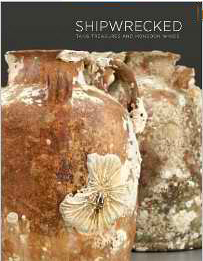
It sent a shockwave through the archaeological community: the venerable Smithsonian Institution was planning a major exhibit on a Tang Dynasty Chinese shipwreck off the coast of Indonesia which had, unfortunately, been salvaged by treasure hunters. Many of the readers of the LAMPosts blog are familiar with the longstanding controversy regarding treasure hunters‘ destructive techniques of wreck salvage and their standard practice of selling artifacts, both of which lead to a loss of knowledge which could have been gained through archaeological inquiry. Archaeologists follow strict scientific standards, and never sell their collected data, and there is a clear distinction between scientific archaeology and the commercial salvage of shipwrecks by treasure hunters. Treasure hunting is simply considered unethical by professional archaeological standards, as is purchasing or displaying artifacts recovered by treasure hunters. The Belitung Wreck was immediately recognized as one of the most important archaeological discoveries ever made in Asia, due to its wealth of preserved artifacts related to the famed “Maritime Silk Road,” and we may never know the extent of the information we have lost due to salvage by treasure hunters. So it is easy to imagine the frustration and anger in the historic preservation and archaeological communities when it was reported that the Smithsonian was going to sponsor a major exhibit, putting their seal of approval on a project that contradicted accepted ethical practices and caused the permanent loss of information that could be gained in no other way. As a Smithsonian Affiliate, the archaeologists at LAMP and the St. Augustine Lighthouse were particularly disturbed by the situation.
But a concerted effort by the Advisory Council on Underwater Archaeology (ACUA), the Society for Historical Archaeology (SHA), and many other similar professional organizations, has lead to positive results. The New York Times:
The Smithsonian Institution has indefinitely postponed its plans to mount an exhibition of Chinese artifacts salvaged from a shipwreck because of opposition from archeologists who say the objects were collected by a commercial treasure hunter in a manner that violated professional standards. The exhibition, “Shipwrecked: Tang Treasures and Monsoon Winds,” was tentatively scheduled for next spring at the Freer Gallery of Art and Arthur M. Sackler Gallery, the Smithsonian’s Asian art museums.
The Washington Post has a more detailed account:
After months of discussion, the Sackler Gallery announced Tuesday it was postponing an exhibition of artifacts from the Tang Dynasty that were recovered in a shipwreck.
The exhibition was due to open in March 2012.
“Shipwrecked: Tang Treasures and Monsoon Winds” drew strong criticism from experts in underwater archeology and cultural heritage groups who argued that the excavation of the boat had not meet the field’s standards. They also contended that a show at the Sackler, which is part of the Smithsonian Institution, would seem to give approval to what they considered objectionable methods.
A statement from the museum said he [Julian Raby, the director of the Freer and Sackler Galleries] would continue “discussions with professsional archaeologists and cultural heritage experts regarding the ethical and professional issues raised by the Belitung shipwreck. A number of archaeological organizations have expressed opposition to the exhibition on the grounds that the recovery of the Belitung cargo–one of the largest and most important finds of Tang Dynasty objects ever discovered–was not executed in accord with best practices and to the highest scientific standards.”
As is often the case with treasure hunting expeditions, the entire project was tainted with scandal, beyond even the basic fact that non-scientists were using commercial salvage techniques to dig up one of the most important archaeological discoveries in the eastern hemisphere. The treasure hunter in question has fled Indonesia and is currently under investigation for fraud.
Shortly after the announcement of the postponed exhibit, emails went flying from archaeologists and maritime museum professionals across the U.S. and beyond, exulting in victory after a prolonged and passionate battle for a good cause. One Smithsonian insider wrote in an email to the ACUA :
It was an amazingly powerful and professional movement that was gradually joined by several other organizations, both internal and external to the Smithsonian itself. The result is unprecedented in the Smithsonian’s long history. . . . I think that the factors most critical to the Smithsonian’s decision (in no particular order) were the polite tone of the internal, archaeological and museum communities; the gradual growth, strengthening and spread of the preservation movement; the fantastic handling of the media coverage and its spin (A++ here); the stature of the organizations writing; and the fact that both internal and external groups and individuals spoke together and with the unanimity of conviction.
The general consensus among concerned professionals is that the exhibit postponement will lead to a cancellation, but this is not yet clear. What is clear is that there is a growing body of professionals and members of the public concerned with the preservation of our submerged cultural heritage. The letter-writing campaign will continue until the Smithsonian officially cancels the exhibit. As a proud institutional member of the Smithsonian Affiliates program, I for one am very pleased that the Smithsonian administration made the right decision, and have high hopes they will formally cancel this show rather than lend credence to the unethical practice of treasure hunting on historic shipwreck sites.
If you would like to contact the administrators of the Freer/Sackler Gallery and thank them for withdrawing their support for this exhibit, and thus preventing the further legitimization of treasure hunting, you can do so by writing a letter, email, or making a phone call using the information below:
Freer Gallery of Art / Arthur M. Sackler Gallery
Smithsonian Institution
1050 Independence Ave SW
P.O. Box 37012, MRC 707
Washington, D.C. 20013-7012
202.633.1000 (TTY 202.633.5285)
202.357.4911 (fax)
publicaffairsAsia@si.edu

